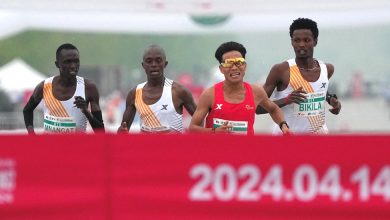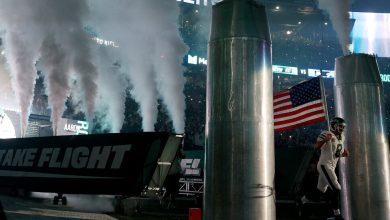Instant Olympians: Just Add Ice

BEIJING — Early last fall, Hockey Canada’s chief executive, Tom Renney, placed a secret call to a retired scout named Blair MacKasey.
The coronavirus pandemic’s threat had seemingly ebbed, but Renney worried that the N.H.L. would abandon its plan to send players to the Beijing Olympics. That decision, if it came, promised to upend Canada’s ambitions for a star-studded, medal-contending roster.
Would MacKasey, Renney asked, suspend his retirement and help develop a contingency plan? MacKasey presumed the project would prove unnecessary, but he nevertheless agreed, and promptly started scrutinizing dozens of players whose only plans for the 2022 Olympics were to watch them on television.
Now, less than two months after the N.H.L. announced its withdrawal from the Games, the urgent deliberations, subtle strategies and clandestine analyses of hockey executives like MacKasey will be tested on one of the biggest stages in sports. The Olympic men’s tournament, largely populated by a jumble of unexpected and unheralded players, opened on Wednesday, when a favored Russian team beat Switzerland, 1-0.
The tournament, usually one of the Games’ most competitive and high-profile affairs, might now be one of its most unpredictable, a series of showdowns decided by men who are essentially instant Olympians. Some are young players who assumed their Olympic aspirations might not be realized until four years from now. A few are older men who figured their prospects of appearing in the Games, for the first time or again, had dimmed. Most of the rest probably believed they were simply not good enough.
Until, suddenly, they were.
“Things snowball in certain directions, and it went the wrong way for those guys,” said Eric Staal, 37, the Canadians’ captain. “And now, for other guys, they get the chance and opportunity.” Staal, who last played in the N.H.L. in the 2020-21 season and in the Olympics in 2010, joked that he felt “well rested” for these Games.
Pat Nagle, a goalie for the United States, said he knew his name had surfaced on mock Olympic rosters soon after the N.H.L. announced its decision to pull out days before Christmas. He said he then heard subsequent rumblings of an invitation to the American team. But he tried not to get his hopes up.
“You don’t know: Are you on a big list? A little list? How many guys are on it?” he said.
Ultimately, at age 34, he received his first Olympic invitation and called his parents. They were elated.
“You start realizing how much bigger of a deal it is maybe then you make it out to be in your own head because you’re trying to keep calm,” Nagle said.

Explore the Games
- Measuring the Medals: Which country is doing best might depend on who’s counting — and how.
- Count the Turns: Eileen Gu won the freeski big air competition after landing a left double 1620. Here is how she did it.
- Olympians and Fear: What scares the most daring Winter Olympians? Three dozen athletes opened up about their fears.
- Bearing the Torch: For China, a Uyghur lighting the cauldron was a moment of ethnic unity. Western critics saw a cynical move.
The U.S. hockey team, announced less than a month ago and the youngest one the country has sent to a Games since 1994, includes only one player who has appeared in a previous Olympics, Brian O’Neill. Seven players have at least some N.H.L. experience, but 15 are currently playing N.C.A.A. hockey.
“We’re no different than a bunch of the teams in this tournament,” the Americans’ coach, David Quinn, said. Quinn has had his job only a bit longer than his players have had theirs: He was elevated to head coach Dec. 27 after the N.H.L.’s decision to play through the Games meant the original pick, Mike Sullivan of the Pittsburgh Penguins, could no longer participate.
“You’ve got to figure it out in a hurry and you kind of have a gut feel of who can play well with who, and some guys have had some experience playing with each other, so you kind of start off with that and then mix and match as you go along,” Quinn said.
Some countries faced less dire circumstances than others because of how their national teams are structured. The availability of the Swedish coach, Johan Garpenlov, did not hinge on the N.H.L., for example. But Garpenlov fretted over the possibility of an Olympics without his best players and said he had two rosters ready. One was known as the N.H.L. scenario, while the other was the European scenario.
The larger challenge, Garpenlov said, was preparing for the competition in a tournament where other teams’ rosters were similarly unstable.
“We did our job with what we could do,” he said. “But in the end, the Americans and Canadians, we didn’t do any scouting on them until we got the decision.”
Once envisioned as a juggernaut with N.H.L. All-Stars like Connor McDavid and Sidney Crosby, the Canadian roster is now more or less the product of an end-to-end raid of the country’s talent pipeline. Staal is 37, but Canada also brought the top prospect Mason McTavish, a center who turned 19 on Jan. 30.
The Canadian officials scrambling to fill their roster quietly weighed scores of potential players, considering not only their skill but whether their teams would make them available for the Games.
Eventually the out-of-sight film sessions and hushed conversations with coaches, though, had to give way to more intensive evaluations, so Canadian officials opted to use a mid-December international tournament in Russia as a laboratory to judge whether their greatest prospects could maybe withstand the rigors of the Olympics. (The Canadians had planned a second, similar effort for another event, but the competition was canceled.)
To entice players to the event, the Channel One Cup, Canadian officials sometimes explained they might wind up in Beijing.
The responses, MacKasey said, were uniformly positive.
“It’s one thing to go to Channel One or Spengler,” he said, “but it’s a whole other kettle of fish when you may have a chance to go to the Olympics.”
Jordan Weal, who has 218 N.H.L. games on his résumé, acknowledged the Olympic undercurrent when he agreed to play, but he said he tried to put Beijing out of his mind. “You kind of knew you were on the radar and stuff like that, so you’re just trying to go there, have some fun, play some hockey and hope for the best,” he said.
Now he and the other instant Olympians are in Beijing, navigating the blizzard of pandemic protocols, training and media obligations and even a team contest for best-decorated suite in the Olympic Village. (“What would our significant others do?” Weal said of his group’s strategy.)
O’Neill, the lone member of the U.S. team with previous Olympic experience, said a dearth of it elsewhere on the roster was not necessarily troublesome.
“Sometimes,” he said, “that’s a huge benefit because being naïve in a moment like this, I think, can be a positive.”
The Olympic novelty, though, goes beyond the players themselves. It is the first Games for MacKasey, 66. For all his recent research, he, like Garpenlov, is not quite sure what to expect.
“Most people are going to turn on their TVs, and they’re not going to recognize 90 percent of the players,” he said. “You’re going to see players — and there are always players or athletes who step out from nowhere and sort of take over or dominate the situation, the scene — who become the players to watch.”




